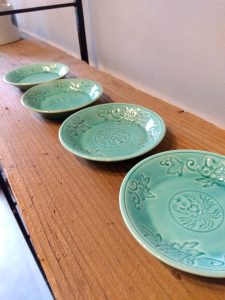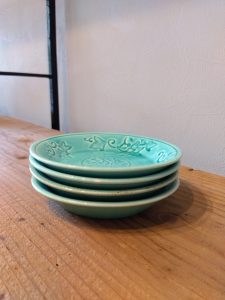髪や肌でも感じる湿気です(愛知県名古屋市千種区姫池通 骨董買取 古美術風光舎)
2024.07.14
皆さまこんにちは。スタッフTでございます。
3連休ですが、すっきりしないお天気ですね。今日の名古屋は午後から雨が降るようですので、湿度増し増しで不快指数MAXです。先日のような自分の身が焼かれるような暑さに比べれば、いくぶんマシかとも思いますが、梅雨時の方がなんだか暑く感じてしまうこともあります。

ほぼ梅雨時にしか聞かない気もしますが、「不快指数」とは蒸し暑さによる不快さを表す指数のことで、気温と湿度から求めた「体感温度の指標」のことを指します。不快指数が高いほど、体感温度が高いことを意味します。
具体的な求め方は(別に覚える必要もないのですが)、0.81×温度+0.01×湿度×(0.99×温度-14.3)+46.3。数式にするとよく分かりませんが、温度が高い、また湿度が高いほど、不快指数、つまり体感温度も高くなるということのようです。
この不快指数が77を超えると、おおよその日本人は不快感を覚えるそうです。
例えば、気温38度、湿度0%のときの不快指数は77。つまり、カラッカラに乾いていれば、38度の酷暑でも不快とはいえないことになります。逆に、湿度100%の時は気温25度で不快指数77。湯気のあふれるお風呂場は、25度を超えると不快と感じるということです。
「不快指数」は高温多湿の日本人にとっては、単なる暑さだけではなく、湿気感としての「蒸し暑さ」を程よく表す目安といいましょうか。 気付けばすっかり市民権を得た言葉となりました。実際の数字はどうであれ、堪え難い日本の夏を代表するにふさわしい言葉であることは間違いありませんね。
ところで、客観的な数値で表される「湿度」に比べ、「湿気」というと何やら親しみさえ感じる不思議さ。昔の人が湿気止めと呼んでおりました乾燥剤を、海苔の缶に入れるだけでなんだか安心感が湧いてくるのは、長年湿気とつきあってきた日本人の習性でしょうか。
またこの時期、天気予報の「洗濯指数」や「服装指数」が役に立ちますが、ところで、いつの間にか「〇〇指数」の種類が増えている気がしますが、気のせいでしょうか。
気になって気象関連のホームページをのぞいてみると、「のど飴」や「アイス」「シミ・リバウンド」まで、見慣れない指数の数々が。「何でもあり?」と突っ込みたくなりますが、「○○指数」は数字の集積である気象データを、いかに暮らしやすさにつなげるかが本質であるそう。「何でもあり」ではないようです。
指数のほとんどは、気温や湿度、風速、降水量など日本気象協会が持つ膨大な気象データを、独自に生み出した計算式から導いており、何をどう掛け合わせるかは「企業秘密」なのだそう。
のどの乾燥しやすさを示す「のど飴指数」や、日焼け止めなど肌のダメージ対策を促す「シミ・リバウンド指数」など、確かに日々の暮らしで目にすると、ちょっと気にして取り入れてみようかなという気持ちになるものです。少々そういった数値に踊らされている感はありますが、確かに日常生活に浸透している気がしますね。
ここで豆知識を一つ。日本気象協会によると、ネットのアクセス数が多いものは、毎日役立つ「洗濯指数」と「服装指数」に、肩を並べるのは天体観測の目安になる「星空指数」なのだそう。
今日のお天気では無理そうですが、星空指数が高いほど綺麗な星空が見られますよ。
日常にロマンが足りないと感じているみなさん、参考にしてみてください(笑)。
ではでは、また。

Hello everyone. This is Staff T.
It’s a three-day weekend, but the weather is not so clear. It is supposed to rain in Nagoya this afternoon, so the humidity is increasing and the discomfort level is at its maximum. Compared to the heat like the other day, when I felt as if I was burning myself, it is a little better, but sometimes I feel hotter than during the rainy season.
The “discomfort index” is an index of discomfort caused by hot and humid weather, and is an indicator of the temperature you feel in your body, calculated from the air temperature and humidity. The higher the discomfort index, the higher the temperature you feel.
The specific formula is (and you don’t have to remember it): 0.81 x temperature + 0.01 x humidity x (0.99 x temperature – 14.3) + 46.3.
When the discomfort index exceeds 77, most Japanese people feel uncomfortable.
For example, when the temperature is 38 degrees Celsius and the humidity is 0%, the discomfort index is 77, meaning that if the air is dry and crispy, even a heat wave of 38 degrees Celsius is not uncomfortable. On the other hand, when the humidity is 100%, the discomfort index is 77 when the temperature is 25°C. This means that a bathroom full of steam is uncomfortable when the temperature exceeds 25°C.
The “discomfort index” is not just a measure of heat for the Japanese, who are used to high temperatures and humidity, but also a good measure of humidity, or “hot and humid”. The term has become a household word. Regardless of the actual number, there is no doubt that it is an appropriate word to represent the unbearable Japanese summer.
By the way, compared to “humidity,” which is expressed as an objective numerical value, “humidity” is a strange and even familiar word. Just putting a desiccant, which people in the past called a “moisture stopper,” in a can of dried laver gives me a sense of relief, perhaps a Japanese habit of dealing with humidity for many years.
Also during this time of year, the “laundry index” and “clothing index” in the weather forecast are very useful.
When I looked at weather-related websites out of curiosity, I found a number of unfamiliar indexes, including “throat lozenges,” “ice cream,” and even “stains/rebounding. I was tempted to ask, “Is anything possible? But the essence of the “XX Index” is how to connect weather data, which is an accumulation of numbers, to the ease of living. It seems that it is not “anything goes.
Most of the indexes are derived from the Japan Weather Association’s vast amount of meteorological data, including temperature, humidity, wind speed, and precipitation, and from original formulas.
The “throat lozenge index,” which indicates how dry one’s throat tends to get, and the “blemish/rebound index,” which promotes measures against sunscreen and other skin damage, are certainly things that, when you see them in your daily life, make you think about adopting them with a little care. Although I feel that we are a little bit dancing around such figures, they certainly seem to have permeated our daily lives.
Here is a piece of trivia. According to the Japan Weather Association, the top three most frequently accessed online weather data are the “laundry index” and the “clothing index,” which are useful every day, and the “starry sky index,” which is a guide to astronomical observation, are on a par with the “laundry index” and the “clothing index.
It may seem impossible in today’s weather, but the higher the starry sky index, the more beautiful the starry sky will be.
For those of you who feel that your daily life is lacking in romance, please take a look at this for reference (laughs).
See you soon.
*******************
ご実家の整理やお片付けなどをされている方のご相談などが多くございます。
お片付けなどくれぐれもご無理のないようになさってくださいませ。
風光舎では古美術品や骨董品の他にも絵画や宝石、趣味のお品など様々なジャンルのものを買受しております。
お片付けをされていて、こういうものでもいいのかしらと迷われているものでも、どうぞお気軽にご相談下さいませ。
また風光舎は、出張買取も強化しております。ご近所はもちろん、愛知県内、岐阜県、三重県その他の県へも出張いたします。
まずは、お電話お待ちしております。
愛知県名古屋市千種区姫池通
骨董 買取【古美術 風光舎 名古屋店】
TEL052(734)8444
10:00-18:00 OPEN

